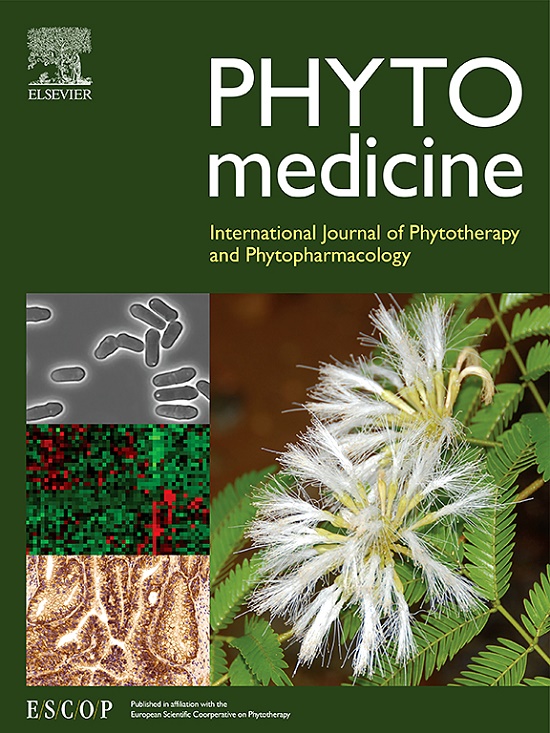Berberine in combination with evodiamine ameliorates gastroesophageal reflux disease through TAS2R38/TRPV1-mediated regulation of MAPK/NF-κB signaling pathways and macrophage polarization
IF 6.7
1区 医学
Q1 CHEMISTRY, MEDICINAL
引用次数: 0
Abstract
Background
Gastroesophageal reflux disease (GERD) is a chronic condition of the digestive tract with limited therapeutic options. Bitter taste receptors (TAS2Rs) and transient receptor potential vanilloid-1 (TRPV1) are implicated in modulating inflammatory responses. Berberine (BBR) and evodiamine (EVO) are known to activate TAS2Rs and TRPV1, respectively. However, whether BBR and EVO can ameliorate GERD by targeting TAS2Rs and TRPV1 remains uncertain.
Purpose
This study aims to determine whether BBR and EVO mitigate esophageal injury by targeting TAS2R38 and TRPV1 and to elucidate their underlying molecular mechanisms.
Methods
A GERD rat model was developed using esophagogastric anastomosis, while GERD in human esophageal epithelial cells (HEECs) was induced via bile acid (BA) exposure. Esophageal pathology was analyzed through hematoxylin-eosin (HE) staining and transmission electron microscopy (TEM). mRNA and protein levels were measured via qRT-PCR, immunofluorescence, immunohistochemistry and Western blot analysis. Small interfering RNA was used to silence TAS2R38 and TRPV1 in HEECs. The activation of TAS2R38 and TRPV1 by BBR and EVO was assessed through Ca2+ mobilization assays. Finally, in vivo validation was conducted using U73122 to inhibit TAS2Rs and resiniferatoxin (RTX) to ablate TRPV1.
Results
BBR and EVO treatments significantly improved esophageal pathology in GERD rats and reduced BA-induced inflammation in HEECs. Additionally, BBR and EVO suppressed proinflammatory factors expression, upregulated barrier proteins such as E-cadherin and claudin-1, and inhibited the phosphorylation of p65, JNK, and ERK in the MAPK/NF-κB signaling pathways in both in vivo and in vitro models. Furthermore, BBR and EVO, whether individually or in combination, reduced dilated intercellular spaces (DIS), increased desmosome numbers, and modulated macrophage polarization in GERD rats. Knockdown of TAS2R38 and TRPV1 in HEECs notably diminished the stimulatory effects of BBR and EVO. Moreover, the regulation of barrier function and MAPK/NF-κB pathway proteins by BBR and EVO in BA-induced HEECs was abrogated upon TAS2R38 and TRPV1 knockdown. Similarly, U73122 and RTX reversed the effects of BBR and EVO on macrophage polarization and MAPK/NF-κB signaling pathways in vivo.
Conclusion
We firstly demonstrate that BBR and EVO alleviate GERD, with enhanced synergistic efficacy observed when used in combination. Mechanistically, BBR and EVO activate the TAS2R38 and TRPV1, respectively, leading to downregulation of phosphorylation in MAPK/NF-κB signaling pathways and modulation of macrophage polarization. These findings offer a novel foundation for the clinical application of BBR and EVO in GERD treatment.
小檗碱联合依伏地明可通过 TAS2R38/TRPV1 介导的 MAPK/NF-κB 信号通路调节和巨噬细胞极化改善胃食管反流病。
背景:胃食管反流病(GERD)是一种慢性消化道疾病,治疗方法有限。苦味受体(TAS2Rs)和瞬时受体电位香草素-1(TRPV1)与调节炎症反应有关。已知小檗碱(BBR)和依伏二胺(EVO)可分别激活 TAS2Rs 和 TRPV1。目的:本研究旨在确定 BBR 和 EVO 是否能通过靶向 TAS2R38 和 TRPV1 减轻食管损伤,并阐明其潜在的分子机制:方法:利用食管胃吻合术建立了胃食管反流大鼠模型,并通过胆汁酸(BA)暴露诱导人食管上皮细胞(HEECs)发生胃食管反流。通过苏木精-伊红(HE)染色和透射电子显微镜(TEM)对食管病理进行分析,并通过 qRT-PCR、免疫荧光、免疫组织化学和 Western 印迹分析测定 mRNA 和蛋白质水平。使用小干扰 RNA 沉默 HEECs 中的 TAS2R38 和 TRPV1。通过 Ca2+ 迁移试验评估了 BBR 和 EVO 对 TAS2R38 和 TRPV1 的激活作用。最后,使用 U73122 抑制 TAS2Rs 和树脂铁氧体毒素(RTX)消除 TRPV1 进行了体内验证:结果:BBR 和 EVO 治疗能明显改善胃食管反流大鼠的食管病理学,并减少 BA 诱导的 HEECs 炎症。此外,在体内和体外模型中,BBR 和 EVO 还能抑制促炎因子的表达,上调 E-cadherin 和 claudin-1 等屏障蛋白,并抑制 MAPK/NF-κB 信号通路中 p65、JNK 和 ERK 的磷酸化。此外,BBR 和 EVO 无论是单独使用还是联合使用,都能减少胃食管反流大鼠扩张的细胞间隙(DIS)、增加脱绒毛体数量并调节巨噬细胞的极化。敲除 HEECs 中的 TAS2R38 和 TRPV1 能明显减弱 BBR 和 EVO 的刺激作用。此外,敲除 TAS2R38 和 TRPV1 后,BA 诱导的 HEECs 中 BBR 和 EVO 对屏障功能和 MAPK/NF-κB 通路蛋白的调节作用也会减弱。同样,U73122 和 RTX 逆转了 BBR 和 EVO 对体内巨噬细胞极化和 MAPK/NF-κB 信号通路的影响:我们首次证明了 BBR 和 EVO 可减轻胃食管反流病,联合使用时可观察到更强的协同疗效。从机理上讲,BBR 和 EVO 可分别激活 TAS2R38 和 TRPV1,从而下调 MAPK/NF-κB 信号通路的磷酸化,并调节巨噬细胞的极化。这些发现为 BBR 和 EVO 在胃食管反流治疗中的临床应用奠定了新的基础。
本文章由计算机程序翻译,如有差异,请以英文原文为准。
求助全文
约1分钟内获得全文
求助全文
来源期刊

Phytomedicine
医学-药学
CiteScore
10.30
自引率
5.10%
发文量
670
审稿时长
91 days
期刊介绍:
Phytomedicine is a therapy-oriented journal that publishes innovative studies on the efficacy, safety, quality, and mechanisms of action of specified plant extracts, phytopharmaceuticals, and their isolated constituents. This includes clinical, pharmacological, pharmacokinetic, and toxicological studies of herbal medicinal products, preparations, and purified compounds with defined and consistent quality, ensuring reproducible pharmacological activity. Founded in 1994, Phytomedicine aims to focus and stimulate research in this field and establish internationally accepted scientific standards for pharmacological studies, proof of clinical efficacy, and safety of phytomedicines.
 求助内容:
求助内容: 应助结果提醒方式:
应助结果提醒方式:


